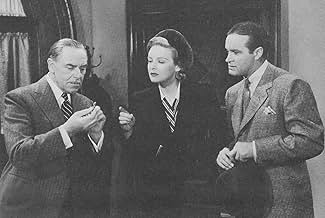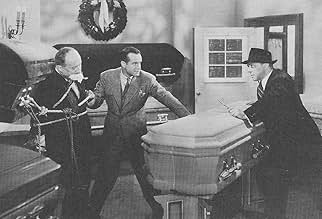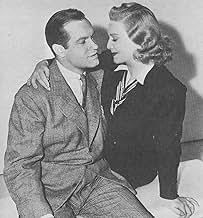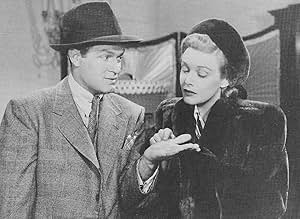IMDb RATING
7.0/10
1.7K
YOUR RATING
Karen Bentley, an English secret agent, links up with Larry Haines and his star penguin Percy in an attempt to outwit German spies.Karen Bentley, an English secret agent, links up with Larry Haines and his star penguin Percy in an attempt to outwit German spies.Karen Bentley, an English secret agent, links up with Larry Haines and his star penguin Percy in an attempt to outwit German spies.
- Awards
- 2 wins total
Featured reviews
This early wartime Bob Hope comedy is one of his best, and is from a time in the comedian's career when his movies hadn't become routine, and when his was a bit less buffoonish and incompetent than in his later efforts. Aided by the lovely Madeline Carroll, Bob is up to his neck in Nazi spies in this satire of Hitchcock-type thrillers, and the "straight" scenes are menacing enough to give the story real bite. The supporting cast is lively and eclectic, and includes George Zucco and Dooley Wilson. Gale Sondergaard is on hand, and as was so often the case in the forties she seems to be doing a send-up of Judith Anderson's malevolent Mrs. Danvers from Rebecca. She does it very well, but one wonders why this beautiful woman was never cast as a female lead. My Favorite Blonde is fast-paced and has some good lines from Hope regulars Frank Butler and Don Hartman. Watching this movie always makes me wonder why Hope's later films, which also tend to be spoofs, are so sloppy, since he is so much funnier and more effective in early vehicles like this one, which are played at least half-straight, and far better for it.
I can't believe no one has reviewed this film until now. The teaming of Bob Hope and Madeleine Carroll in "My Favorite Blonde" is comic heaven. Madeleine Carroll shows a flair for comedy she was rarely allowed to display in her films.
"My Favorite Blonde" is funny, fast, and sharp in the banter between Hope and Carroll. Check out the scene where they get out of what appears to be certain capture: the most hilarious scene in the film. A fine supporting cast of Paramount contractees make this one of Bob Hope's best constructed comedies. It's plotting and editing make this even more of a road picture than the "Road" pictures, a precursor to "Romancing The Stone".
"My Favorite Blonde" seamlessly shows the mixing of '30's romantic comedy with World War II plots, something that would soon become obsolete as the war dragged on. Catch it whenever you can!
"My Favorite Blonde" is funny, fast, and sharp in the banter between Hope and Carroll. Check out the scene where they get out of what appears to be certain capture: the most hilarious scene in the film. A fine supporting cast of Paramount contractees make this one of Bob Hope's best constructed comedies. It's plotting and editing make this even more of a road picture than the "Road" pictures, a precursor to "Romancing The Stone".
"My Favorite Blonde" seamlessly shows the mixing of '30's romantic comedy with World War II plots, something that would soon become obsolete as the war dragged on. Catch it whenever you can!
A good spy thriller: British agent Madeleine Carroll attempts to transport a scorpion-shaped brooch that conceals microfilm holding key military information. She is chased by Nazi spies led by George Zucco and Gale Sondergaard. Two agents are killed in the first ten minutes.
Cut to Bob Hope—or rather, his penguin. Hope and penguin are Haines and Percy, a sort of vaudeville act. The penguin has just gotten the call from Hollywood; Hope would like to think that he is the real star. Paths cross when Carroll, hoping to shake the Nazis from her trail, ducks into Hope's dressing room. And the fun begins.
Needing cover and hoping to conceal her true identity, Madeleine feigns romantic interest in Bob, and plays it up good. He is surprised and mystified by her attention—and soon by attention from Zucco and gang, who want the scorpion and know he is somehow involved. The scene where spies surround and stare him down on the train's club car is classic Hope, as his nervousness starts slowly but gradually bubbles over.
The scenes between Hope and Carroll are even better she plays it fairly straight and he plays it goofy and the interplay just works like a charm. One especially funny scene in the train compartment: having pressed up close to him with a kiss and retrieved the brooch from his lapel, she stands up and moves away; not having a clue, Hope grabs her and tries to kiss her again—and she slaps him indignantly. "Take your hands off me!" she snaps. Poor Bob.
The dialog is bright and funny throughout, with Hope naturally getting the best lines, including some vintage Hope gems: "I've given up kissing strange women." "What made you stop?" "Strange women."
Zucco and Sondergaard have only small roles, but they sure can play the baddies. Talk about sinister!
However, Bob and Madeleine are pretty much the whole show here. The relationship between the two leads develops nicely—we have a pretty good idea how it's going to turn out, but it grows at a careful pace, not too fast or too slow or too sudden.
Top notch and full of great laughs.
Cut to Bob Hope—or rather, his penguin. Hope and penguin are Haines and Percy, a sort of vaudeville act. The penguin has just gotten the call from Hollywood; Hope would like to think that he is the real star. Paths cross when Carroll, hoping to shake the Nazis from her trail, ducks into Hope's dressing room. And the fun begins.
Needing cover and hoping to conceal her true identity, Madeleine feigns romantic interest in Bob, and plays it up good. He is surprised and mystified by her attention—and soon by attention from Zucco and gang, who want the scorpion and know he is somehow involved. The scene where spies surround and stare him down on the train's club car is classic Hope, as his nervousness starts slowly but gradually bubbles over.
The scenes between Hope and Carroll are even better she plays it fairly straight and he plays it goofy and the interplay just works like a charm. One especially funny scene in the train compartment: having pressed up close to him with a kiss and retrieved the brooch from his lapel, she stands up and moves away; not having a clue, Hope grabs her and tries to kiss her again—and she slaps him indignantly. "Take your hands off me!" she snaps. Poor Bob.
The dialog is bright and funny throughout, with Hope naturally getting the best lines, including some vintage Hope gems: "I've given up kissing strange women." "What made you stop?" "Strange women."
Zucco and Sondergaard have only small roles, but they sure can play the baddies. Talk about sinister!
However, Bob and Madeleine are pretty much the whole show here. The relationship between the two leads develops nicely—we have a pretty good idea how it's going to turn out, but it grows at a careful pace, not too fast or too slow or too sudden.
Top notch and full of great laughs.
After swooning for quite some time on his radio show about Madeline Carroll, the actress, enjoying the publicity, approached him about being a guest on his show. Hope suggested that instead, they do a film together. The result is the delightful "My Favorite Blonde" about a British spy, Carroll, trying to deliver a coded message to Los Angeles. Attempting to escape German agents, she barges into a theater dressing room inhabited by Hope, who is performing as straight man to a penguin.
Hope is a riot, with the wisecracks coming quickly throughout the film, and Carroll is a good leading lady for him - classy, serious, and the character she plays is game for anything to reach her goal. Gale Sondergaard has precious little to do - one wonders if her role was cut; Dooley Wilson has an unspoken bit on the train; and Bing Crosby directs Hope to a bus in one scene. Hope starts to walk away from him, stops, takes a beat and says to himself, "No. It couldn't be." There are other in jokes as well - Hope turns the radio to his own show and turns it off, commenting, "I can't stand that guy." As someone who was a young adult in the '60s, it wasn't kosher to like Bob Hope because of his politics, but I've always enjoyed his film performances. "My Favorite Blonde" is one of his best.
Hope is a riot, with the wisecracks coming quickly throughout the film, and Carroll is a good leading lady for him - classy, serious, and the character she plays is game for anything to reach her goal. Gale Sondergaard has precious little to do - one wonders if her role was cut; Dooley Wilson has an unspoken bit on the train; and Bing Crosby directs Hope to a bus in one scene. Hope starts to walk away from him, stops, takes a beat and says to himself, "No. It couldn't be." There are other in jokes as well - Hope turns the radio to his own show and turns it off, commenting, "I can't stand that guy." As someone who was a young adult in the '60s, it wasn't kosher to like Bob Hope because of his politics, but I've always enjoyed his film performances. "My Favorite Blonde" is one of his best.
Madeline Carroll is British spy Karen Bentley, she has in her possession British aeroplane plans that the Nazis obviously want, so she's on the run with the baddies in hot pursuit. During one escape she hides away in a theatre and comes across Larry Haines (Bob Hope) and his performing penguin Percy, she doesn't have to work hard to get Haines smitten with her and he helps her escape. This sets us up for a mad cap cross country chase movie with quips aplenty and incredulous scenes to enjoy. Hope is on prime form and the chemistry between Carroll and himself is one of the film's chief bonus points, and in view of the back story to the film it's not hard to see why the pair were a believable duo. By all accounts Hope really had the hots for Carroll and she spent the whole shoot fighting him off since she was happily involved with Sterling Hayden at the time. It's a fun film that takes a while to get going, but once it does it doesn't disappoint on the fun front, and Bing Crosby of course turns up for one of his many cameos. 7/10
Did you know
- TriviaBing Crosby: as a man outside the union hall.
- GoofsWhen the penguin roller skates down the ramp in the stage act, wires are visible on the skates.
- Quotes
Larry Haines: "Is that your real hair or did you scalp an angel?"
- Crazy creditsThe opening title cards read: BOB HOPE who calls MADELEINE CARROLL "MY FAVORITE BLONDE"
- SoundtracksSobre las Olas (Over the Waves)
(1887)
Written by Juventino Rosas
Played during the Haines and Percy vaudeville act
Reprised for subsequent acts
- How long is My Favorite Blonde?Powered by Alexa
Details
- Runtime1 hour 18 minutes
- Color
- Aspect ratio
- 1.37 : 1
Contribute to this page
Suggest an edit or add missing content








































